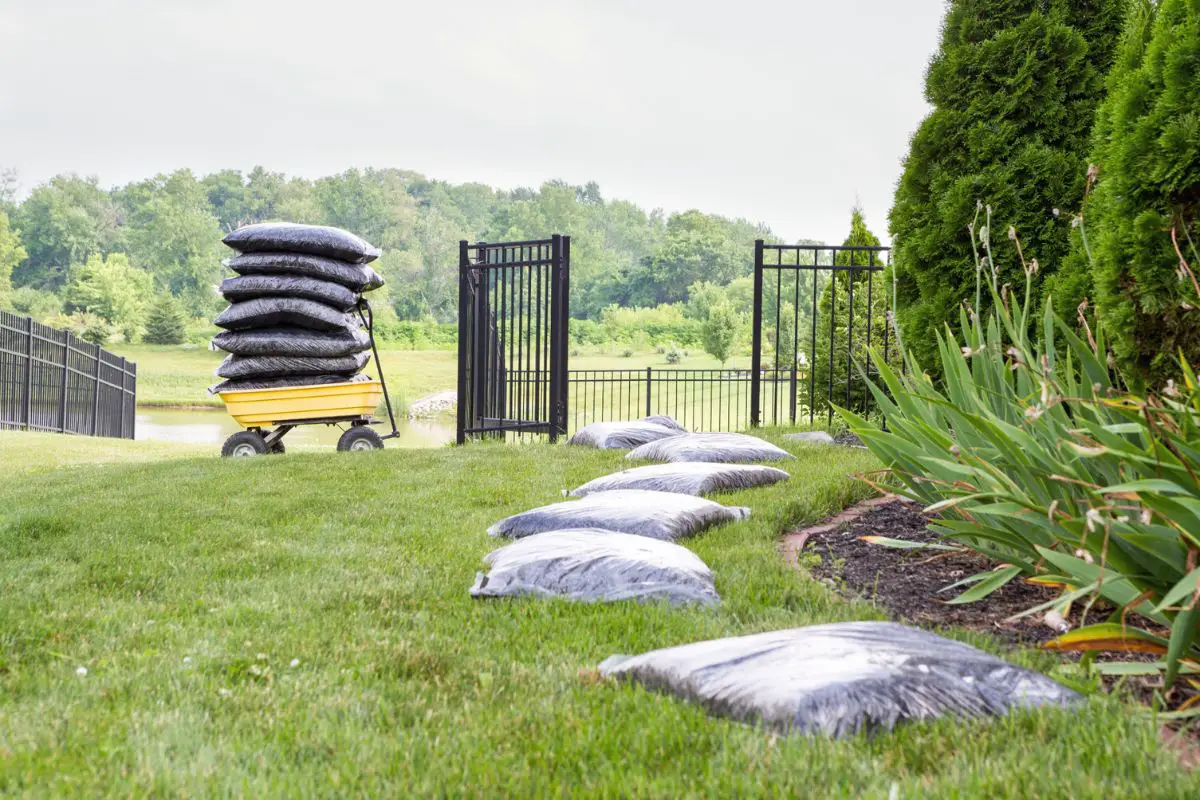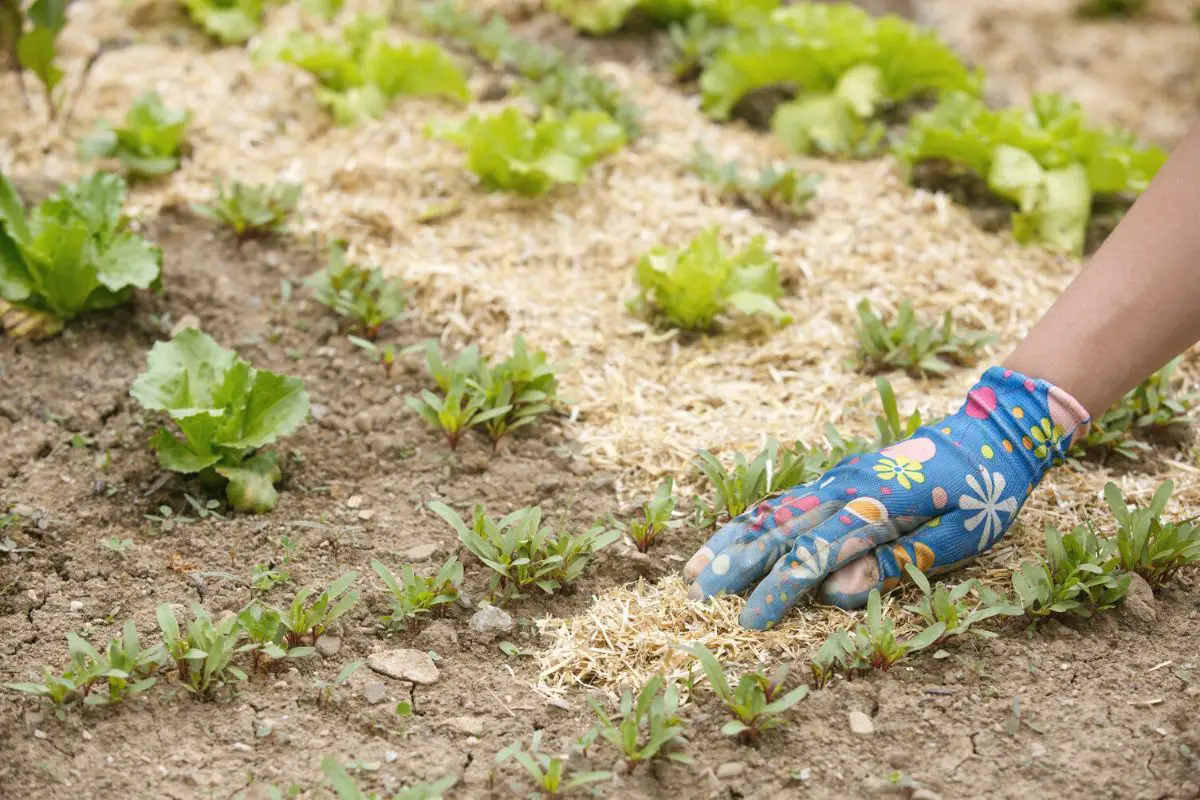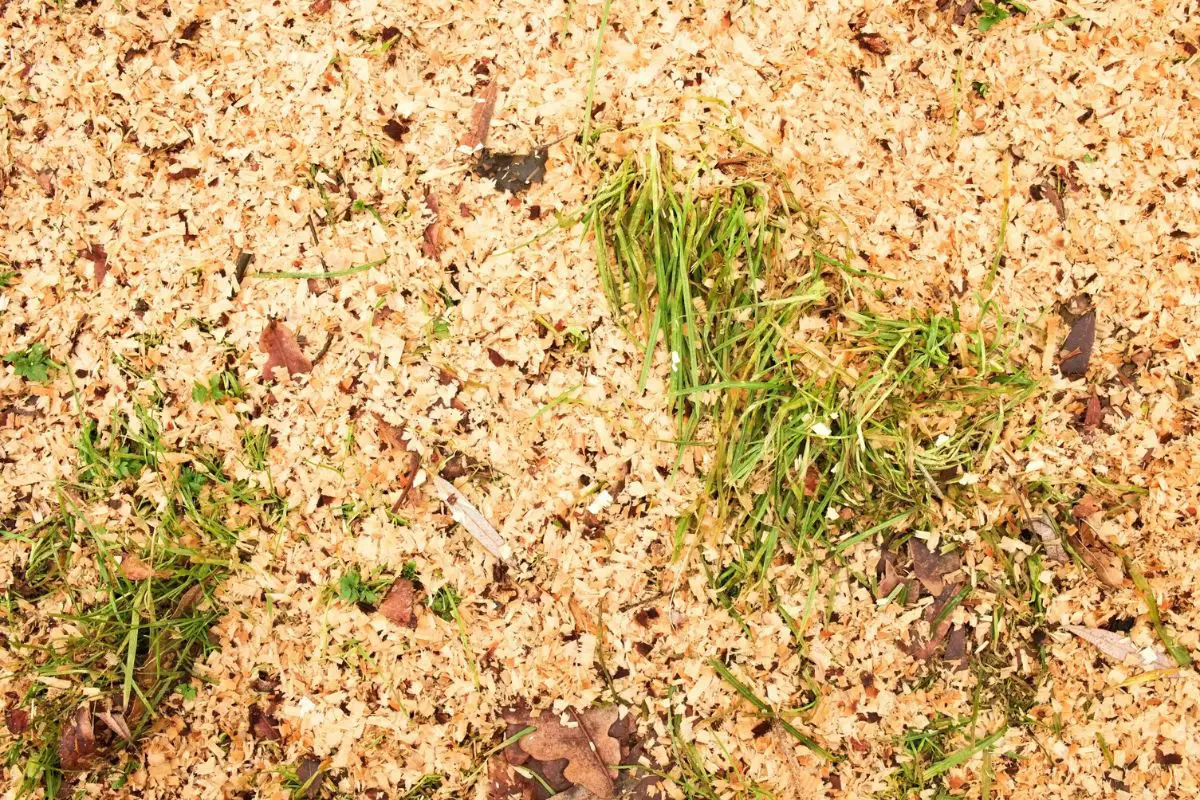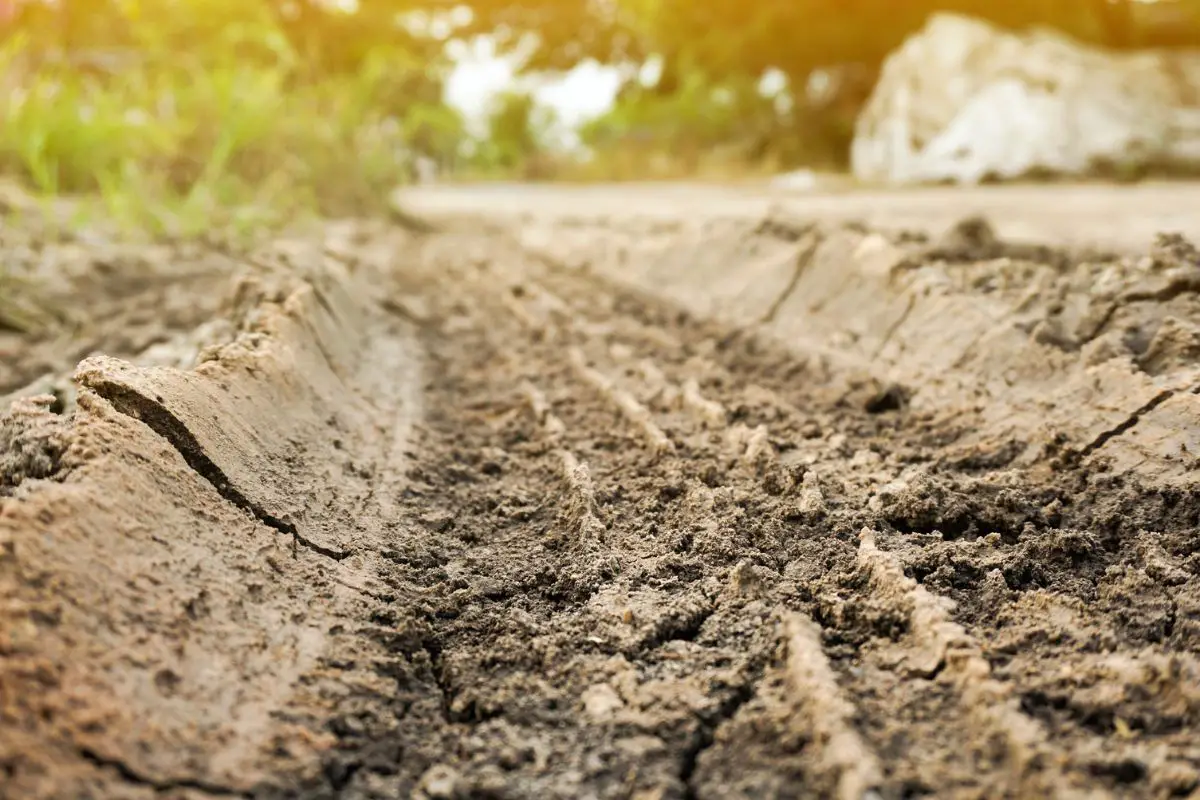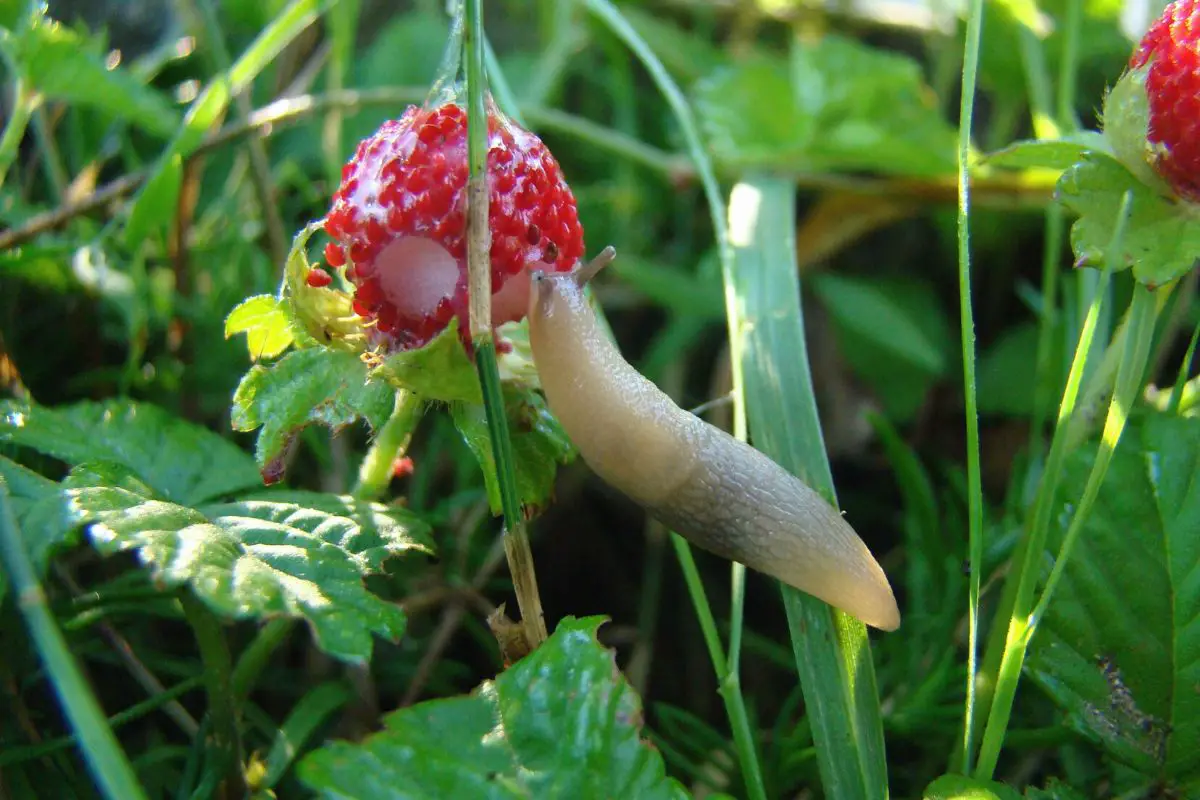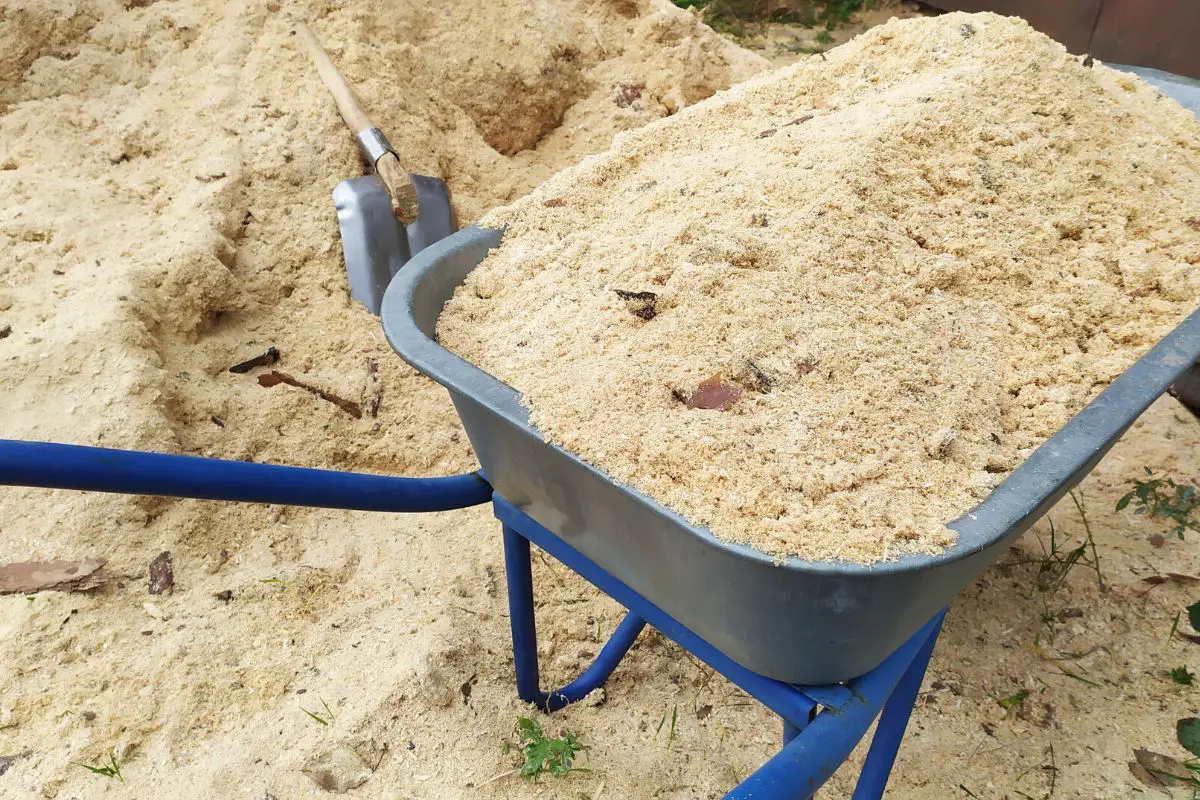Organic mulch has become a staple in gardening. With the improvement in the courier service industry, various plant species have become accessible globally. However, many plants cannot thrive in regions outside their native habitat without help from good-quality mulch.
The benefits of organic mulches in gardening include protection from extreme temperatures, weeds, rapid moisture loss, and erosion. In addition, they’re sourced from plant by-products that return essential nutrients to the soil as they decompose.
If you’re still on the fence about using organic mulch, you’ve come to the right place. In the rest of the article, I’ll explain everything you need to know about organic mulch: its benefits, the different types, application guidelines, and how it compares to inorganic mulch.

Organic Mulch: An Overview
When introducing foreign plants into your home garden, there’s no guarantee that they will survive. Using organic mulch is the closest you can get to replicating nature in protecting your new plants from the elements they’re not familiar with.
Organic mulch comes from plant waste products. Even materials processed from plant sources, such as cardboard and newspaper, can be used as organic mulch.
Depending on the source, organic mulches can be carbon-rich or nitrogen-rich materials that can improve the organic matter content of your soil and naturally infuse it with essential nutrients as they decay.
Due to their benefits in gardening, organic mulches have become widely available and can be purchased from gardening supply stores or from local providers in bags or in bulk.
Here are some examples you can choose from:
- Compost
- Sawdust
- Straw
- Hay
- Grass clippings
- Dried leaves
- Bark
- Wood chips
- Pine needles
- Cardboard
- Newspaper
Cover crops like clover and alfalfa are also often referred to as living mulch because they provide similar benefits to other organic mulches.
Benefits in Gardening
Indoor gardening is often more convenient when growing non-native plant species because it’s easier to manage environmental conditions, such as temperature, light, and humidity. In addition, potted plants are unlikely to encounter weed problems.
However, such issues shouldn’t prevent you from growing your desired plants in an outdoor garden.
Thankfully, organic mulches can make it possible with the following benefits:
Weed Suppression
One of the most important functions of mulch is to suppress weed growth on bare soil so your garden plants won’t have to compete with weeds for moisture and nutrients.
Weeds are sturdy and highly prolific. Left unattended, they can quickly take over your garden and leave your plants starving and dehydrated. Luckily, they’re easy to suppress with about 4 inches (10 cm) of organic mulch.
The mulch layer can block the sunlight from reaching the soil and prevent the weed seeds from sprouting. However, not all organic mulches are effective at controlling weeds.
Some less effective materials for suppressing weeds include the following:
- Hay may contain and introduce weed seeds in your garden.
- Fine-grade sawdust must be applied thinly (only up to 2 inches or 5 cm) to prevent crusting on the surface. The thin layer is not enough to suppress weeds.
- Finished compost’s nutrient-rich nature and fine texture makes it easy and convenient for weeds to grow through.
More importantly, proper timing is crucial to controlling weeds using organic mulch. You can apply the mulch in the spring or fall, but there are a few things to consider for the mulch to be effective:
Spring Application
Wait for the soil to warm up for seeding or transplanting before applying mulch. When sowing seeds in spring, the ground has to be warm enough (over 55 °F or 13 °C) for higher germination rates.
Applying the mulch too soon can keep the soil too cool for the seeds to sprout or young seedlings to establish their roots.
The downside with waiting is that some perennial weeds can grow earlier than your perennial plants or right before the soil warms up enough for seed sowing or transplanting seedlings.
To deal with the issue, uproot the weeds that sprout in the spring using a garden hoe or weeding knife. You can leave them in the ground after hoeing and let them dry up. As they decompose, they can enrich the soil.
Alternatively, these newly sprouted weeds likely don’t have seeds yet, so it’s okay to add them to your compost pile.
However, weeds that have flower heads will need to be thrown away. Avoid putting them in the compost pile unless you’re confident your compost can heat up to over 140 °F (60 °C) for about 1-3 hours to kill common weed seeds like sowthistle and pigweed.

Fall Application
There are two main reasons for applying mulch in the fall: to protect plant roots from freezing temperatures and to prevent weeds from taking over the garden while the plants remain dormant.
Although it’s crucial to apply mulch before the cool-season grasses sprout, there are two things to consider for timing your mulch application in the fall:
- Apply the mulch before the first frost if you have plants that may rot from the freeze-and-thaw cycle. This includes all tender plants like begonias and caladiums and root crops like carrots, beets, turnips, and potatoes. Thick mulches like bark and wood chips do great for this purpose.
- Apply the mulch after the first frost for hardy plants like peonies and columbines that require the freeze for dormancy. This will ensure that the plant will bounce back and produce flowers the following year. Long-lasting organic mulches, such as straw and wood chips, are excellent in this case.
Pro tip: Uproot any weeds that sprout before applying your organic mulch of choice.
Moisture Retention and Reduced Watering Needs
Rainwater is the best water source for gardens and indoor plants. However, it’s not always available, so you must supply your plants with water regularly on dry days.
Summer temperatures can be too high, causing the soil moisture to evaporate rapidly. Applying about 2-4 inches (5-10 cm) of organic mulch is often enough to keep the plant’s root zone moist for longer.
A mulch layer keeps the water within the soil underneath it long enough until the plant’s roots are adequately hydrated. The excess can then be drained underground beyond the reach of the roots.
Fine mulch materials like compost and sawdust also hold plenty of moisture that they can release into the soil or atmosphere. Losing the moisture gradually through evaporation can temporarily raise the humidity just around your plant.
Therefore, using organic mulch in your garden can reduce the watering frequency and still keep the plants well-hydrated.
Temperature Regulation and Root Protection
Extreme heat or freezing temperatures can be damaging to your plant’s roots and can lead to stunted growth or even plant death. Organic mulch can do wonders in keeping your garden plants alive and thriving despite extreme seasons.
Winter Insulation
Applying about 4 inches (10 cm) of organic mulch can insulate the soil and keep the root zone warm even during freezing winters. The mulch and the soil will absorb heat during the day and radiate the energy during a cold night, keeping the soil temperature almost stable.
Despite the freezing temperatures and most of the plant’s foliage dying out, the roots remain active underground. As long as the roots remain protected, plants will survive through winter and bounce back in the spring.
Summer Protection
Conversely, as the air temperatures rise in the summer, the mulch layer can trap moisture within the soil and keep it cool. The soil and its water content take longer to heat up despite the fluctuating air temperatures.
It’s also one of the reasons why an organic mulch layer can effectively retain moisture in the soil. Since the temperatures underneath the mulch remain almost stable, there’ll be a delay in moisture loss through evaporation.
The plant will transpire more during hot and dry days and will result in a vacuum-like reaction that sucks water from the ground through its roots. Thankfully, since the mulch layer can hold the water within the root zone, the plant will have enough to keep it hydrated for longer.
Without an organic mulch layer, the soil will heat up faster and dry the plant out quickly.
On another note, this marks the significant advantage of organic mulches over inorganic ones because the latter tend to absorb and trap heat, causing the roots to overheat.
Erosion Control
Heavy rains can compact the soil and cause water to run off the surface. The runoff will erode the soil over time. On the other hand, strong winds can erode dry soil particles by blowing them away.
Protection from Heavy Rains
Woody organic mulches like wood chips and bark or fibrous ones like straw, pine needles, and grass clippings can absorb the brunt of heavy raindrops and facilitate excellent penetration into the soil.
As a result, rainwater isn’t lost as runoff, and the soil underneath remains porous and well-hydrated.
Defenses From Wind Erosion
Dense mulch materials like wood chips and bark, when wet, are more resistant to strong winds than lightweight materials like sawdust and straw.
If you only have lightweight organic mulches but live in a windy area, you can install windbreaks like fences or a hedge as additional protection against wind erosion.
Soil Enrichment and Fertility Improvement
Dried leaves and branches fall from trees or shrubs all year round and provide a mulch layer over the soil. This is nature’s way of organically keeping wild plants alive with little to no human intervention.
Over time, these organic materials break down in the soil and release nutrients for the plants to use. They turn into humus that improve the texture of the soil and increase biological activities within it.
Applying organic mulches in your garden will have the same results over time. However, different types of mulch types will release different levels of nutrients.
For instance, leafy mulches like grass clippings contain higher amounts of nitrogen. On the other hand, woody mulches like wood chips, bark, and sawdust contain more carbon.
In addition, organic mulches can improve soil fertility by adding small amounts of the following nutrients:
- Phosphorus
- Potassium
- Calcium
- Sulfur
Note that the decomposition of organic materials applied as mulch is much slower than when they’re tilled into the soil. Therefore, organic mulch can work as a slow-release source of organic matter and nutrients that can rejuvenate your garden soil after the growing season.

Enhanced Microbial Activity
As discussed, organic mulch can improve moisture retention, keep the soil warm or cool, and add organic matter. All these factors activate soil microbes that facilitate most of the important biological and chemical processes in the soil.
Without the mulch layer or organic amendments as a fresh source of organic matter, these soil microbes can remain dormant.
Once activated, nitrifying bacteria can convert nitrogen fertilizers into forms that are readily accessible to plant roots. Fungi and actinomycetes also contribute to the decomposition of organic mulch and release nutrients to the soil.
Pros and Cons of Different Mulch Types
Organic mulches share the same benefits listed above. However, they’re not all the same in their degrees of effectiveness. If you’re not sure which type of mulch to use in your garden, you can refer to the data below.
This table shows where the different types of mulches are best suited and their corresponding pros and cons:
| Mulch Type | Best for | Pros | Cons |
|---|---|---|---|
| Compost | All types of gardens |
|
|
| Sawdust | Vegetable, flower, and ornamental gardens |
|
|
| Straw | Vegetable gardens, trees, and shrubs |
|
|
| Hay | Vegetable, flower, and ornamental gardens |
|
|
| Grass Clippings | Lawns and vegetable gardens |
|
|
| Dried Leaves | Vegetable and flower gardens, shrubs |
|
|
| Bark | Trees, shrubs, perennial plants |
|
|
| Wood Chips | Trees, shrubs, perennial plants |
|
|
| Pine Needles | Vegetable gardens, shrubs |
|
|
| Cardboard | Perennial plants and trees |
|
|
| Newspaper | Flower and ornamental gardens |
|
|
Among the materials listed above, I’ve found much success in using compost as mulch in my vegetable garden. I often apply about 2-3 inches (7.6-10 cm) of finished compost in spring and summer because it can help keep the soil cool and retain moisture.
I just need to top it up every month because it shrinks faster than other organic mulches. More importantly, there’s no risk of compaction or crusting on the soil surface (unlike sawdust) because of the natural porosity of finished compost.
It also reduces the need to fertilize my plants later in the season since the compost slowly but readily releases essential nutrients to the soil.
However, I noticed that partially finished compost works better in fall and winter because the decomposition process can help keep the soil warm.
The decomposition process can halt as the freezing temperatures force the microbial decomposers into dormancy. However, using unfinished compost with coarse chunks of partially decomposed yard waste like wood chips and bark was enough to keep the roots safe throughout winter.
Pro tip: Avoid using unfinished compost in your garden if it contains food or kitchen scraps. These will certainly invite rodents and insects into your garden. If you compost at home and plan to use it during the cold season, ensure that your pile doesn’t contain fruits or peels.
Application Guidelines
Timing is not the only important factor to consider when applying organic mulches to any garden.
You should also pay attention to the following details:
- Thickness and coverage
- Application around plants and trees
- Maintenance and top-ups
Let’s discuss these further below:
Thickness and Coverage
Mulch is clearly important for gardens, but too much can actually be harmful to your plants.
Excess mulch can present the following risks:
- It can suffocate the plant roots. A thick layer of mulch can prevent adequate air penetration into the soil layer below. It can also keep the water within the root zone for too long due to a decreased evaporation rate. As a result, the plant roots will not be able to take in enough oxygen and drown.
- Seeds fail to germinate. Each plant species requires a different sowing depth to ensure higher germination rates. Very thick mulch can prevent seeds from germinating because they won’t be able to access enough sunlight.
- Excess mulch becomes a breeding ground for pests and plant pathogens. Unfortunately, harmful insects and microbes are also attracted to the organic matter present in the mulch. Excess mulch makes the plants vulnerable and unable to fight off these pests and diseases.
The above risks can be detrimental to your garden. Therefore, it’s crucial to limit the thickness and coverage of your mulch with the following considerations:
Seeding
When direct-sowing seeds in your garden, reduce the sowing depth by ¼ if you’re applying mulch. For instance, if the original sowing depth is 2 inches (5 cm), reduce it to 1.5 inches (3.8 cm) and add an inch (2.5 cm) of mulch.
You can increase the mulch depth later as the plant reaches at least 6 inches (15 cm) tall.
Winter Protection
For optimum winter protection, the mulch should be 3-4 inches (7.6-10 cm) deep. This can keep the frost depth well above the root zone. Avoid trying to increase the thickness, thinking it will offer better protection.
Note that the soil needs to absorb the sun’s heat during the day to stay warm during the night. If the mulch is too thick, the heat won’t reach deep enough into the soil.
Summer Protection
In the summer, about 2-4 inches (5-10 cm) of mulch is enough to slow down evaporation and keep the moisture within the soil.
If the mulch layer is too thick, it can prevent air circulation and overheat the plant roots.
Weed Suppression
About 2-4 inches (5-10 cm) of mulch is often enough to keep weeds at bay.
However, finer mulch materials like sawdust and compost might not be very effective at suppressing weeds. Their fine texture resembles that of your garden soil, and weeds can grow through them.
Sawdust can also build up on your lawn and be difficult to remove.
Erosion Control
Apply about 2 inches (5 cm) of any organic mulch to take in the impact of rain and prevent soil erosion.
If your area has heavy rains that weigh down on your mulch layer, you can increase the thickness to 4 inches (10 cm).
Pathways
If you need to walk around your garden and have bare patches of soil, you can apply 4-6 inches (10-15 cm) of mulch over them.
The mulch layer will prevent compaction in the soil underneath and also suppress weeds. Straw or sawdust is excellent for this purpose.

Application Around Plants and Trees
When applying organic mulch around plants and trees, ensure that the layer is even. Avoid piling the mulch too close to the crown or stem of your plants. If the mulch holds moisture, this can cause stem or crown rot in your plant.
In addition, there will be uneven moisture and heat in the soil if the mulch layer has an uneven thickness.
Keep a 1-2 inch (2.5-5 cm) distance between the mulch layer and your plant’s crown or stem. If you cover your seeds with mulch upon sowing, make sure to move the mulch sideways as the stem gets taller.
You’ll also need the space for fertilizer applications, especially since you’ll need to apply the fertilizer directly into the soil. Otherwise, the nutrients will be lost to the mulch layer—especially nitrogen if you’re using carbon-rich mulches.
Granular fertilizers can be applied 2 inches (5 cm) away from the crown of the plant and about 1-2 inches (2.5-5 cm) deep into the soil for faster nutrient release and facilitate better root accessibility. Too close, and your roots will suffer fertilizer burn.
Maintenance and Top-Ups
Check on your mulch layer every 1-2 months. Since organic mulches decompose over time, it’s crucial to inspect them regularly to make sure they’re thick enough to serve their purpose.
Compost, aged sawdust, and shredded leaves can break down as quickly as one season (2-3 months) in a well-maintained garden that receives adequate water and nutrients.
Even dense materials like wood chips and bark can also shrink after the freeze and thaw cycles in winter.
Either way, you must top up the mulch layer as needed. For instance, if the original depth is 3-4 inches (7.6-10 cm) but the mulch layer has shrunk to only 2 inches (5 cm), you must add enough mulch to bring it up to your desired depth.
Also, it’s important to keep lightweight mulch materials like straw, pine needles, and sawdust well-hydrated to protect them from the wind.
Impact on Plant Health
Organic mulch is a famous choice among many gardeners because of its fantastic effects on plant health. Considering the above-mentioned benefits, a properly applied organic mulch layer can significantly improve the quality of your garden plants.
Here are the positive impacts of organic mulches on your plant’s health:
Nutrient Release and Soil Conditioning
Most plants consume nutrients during their growing season and return a portion of these nutrients to the soil as they die and decompose. However, perennials will naturally deplete the available nutrients in your garden soil over time.
To keep the soil rich and the plants nourished, gardeners apply fertilizers regularly—whether organic or chemical. Organic mulches don’t only protect your garden plants from the elements but also replenish the soil nutrients and maintain good texture.
These functions can reduce the amount and frequency of fertilizer applications. It can also maintain the health of your garden soil, making it suitable for years and years of gardening.
Disease Prevention
Plant pests and pathogens are present everywhere regardless of how careful you are with your garden. Although prevention is undeniably better than cure, that’s not always the case when dealing with outdoor plants, which are exposed to the elements all the time.
If your plant is suffering from several stressors, such as watering issues and extreme temperatures, it’ll be more likely to succumb to the damage caused by pests and diseases.
However, due to the protection provided by the organic mulch, your garden plants will become healthier, making them more resistant to pests and diseases. In addition, they’ll have higher chances of recovering after a timely application of appropriate treatments.
Beneficial Insects and Wildlife Attraction
An organic mulch layer has a warm and moist environment underneath it. As a result, it can attract a wide variety of insects, including beneficial and harmful ones.
Earwigs are among the beneficial insects that love organic mulch. Although they can attack your seedlings or young plants, they’re not a threat to mature plants. As a matter of fact, they can protect your garden from common pests like aphids, mites, and thrips.
Other beneficial wildlife that can visit your mulched garden soil are earthworms and beneficial nematodes.
As earthworms feed on organic matter, they excrete worm castings that are rich in nutrients, such as nitrogen, phosphorus, sulfur, and calcium. They also create tunnels that improve aeration and facilitate better root growth.
Beneficial nematodes, on the other hand, are attracted to soil microbes like fungi and bacteria. As the nematodes feed on them, their population can remain under control and prevent potential damage to the plants.
Unfortunately, snails and slugs are common garden pests that are also attracted to the moisture and protection the mulch layer provides. Organic mulch materials like straw are actually conducive for these pests to hide during the day.
I used to apply straw mulch around my leafy vegetable garden because it’s cheap and easy to find. However, I noticed bite marks and slime left behind by snails and slugs. The following growing season, I replaced the mulch with sawdust and noticed an improvement in the appearance of my leafy vegetables.
Pro tip: Coarse mulch materials like bark, sawdust, and wood chips can deter slugs and snails from getting too close to your plants. The rough texture of the mulch can injure these soft-bodied pests, making them unlikely to force their way to your plants. Moreover, I’ve tested various organic methods to control slugs and snails, including liquid coffee and grounds, crushed eggshells, and garlic spray. The most effective one was the coffee treatment.
Environmental Benefits
In addition to plant health, organic mulch also has a positive impact on the environment.
Let’s look at the environmental benefits below:
Sustainability and Reduced Landfill Waste
According to the US EPA, yard waste constitutes about 20% of all the garbage generated in the US. This is also a global issue that needs to be addressed. In response, the number of people becoming interested in sustainable gardening has been steadily increasing in the past decade.
Composting at home using kitchen scraps and yard waste has become popular due to people’s increased awareness of the benefits of organic materials. It’s also an effort to reduce landfill waste.
Using organic mulch is also an economic decision since gardens and lawns generate a large volume of waste year-round, such as dried leaves and grass clippings.
Carbon Sequestration
Organic mulching also helps mitigate global warming by capturing and storing carbon dioxide into the soil for longer periods.
Carbon sequestration is more effective when using long-lasting mulch materials like straw, wood chips, and bark around perennial plants like trees and shrubs.
Improved Soil Health and Biodiversity
The abundance of fresh organic matter in organic mulch encourages the biological and chemical activities of beneficial microbes like bacteria, fungi, and actinomycetes. As they break down the organic matter, they improve the texture and fertility of the soil.
Even earthworms and beneficial nematodes can become active in your soil. They help aerate the soil effectively as they feed on organic matter and potentially harmful microbes, respectively.
That said, a good layer of organic mulch can keep your soil’s ecosystem balanced and active.
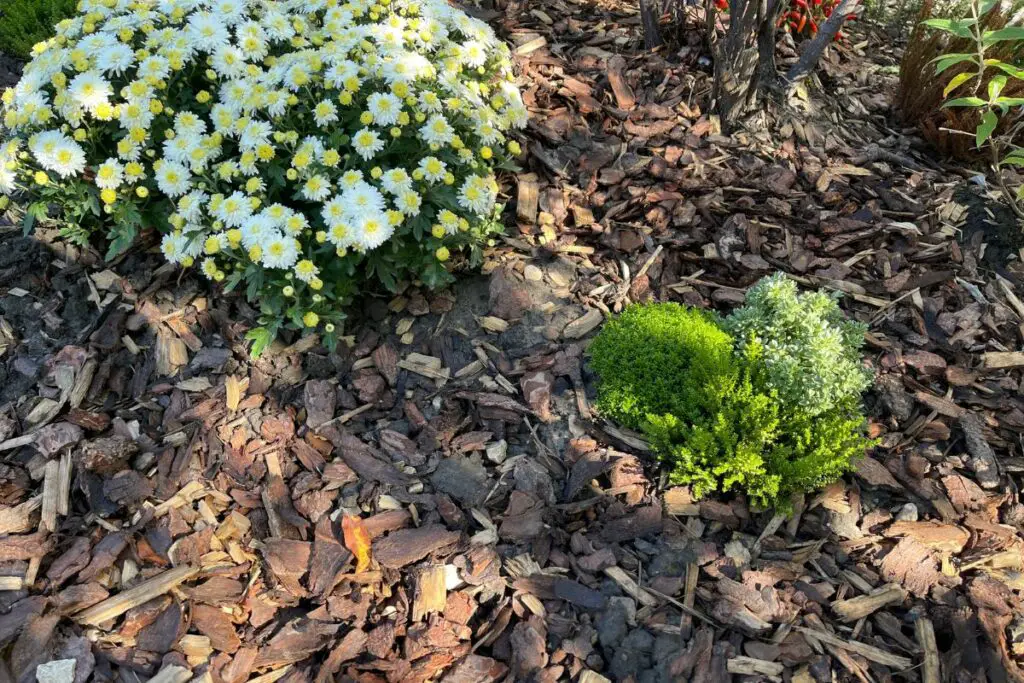
Common Misconception: Termites and Mulch
One common misconception many new gardeners have is that using organic mulch invites termites into your home.
However, termites are unlikely to build a colony underneath the mulch layer. If anything, termites consider the mulch a good passageway because they remain protected underneath the layer.
As discussed, mulch decomposes and gradually incorporates into the soil. If your mulch is well-maintained with enough water and nutrients, it will decompose faster.
Raking the mulch layer regularly—about once every 1-2 months—will relieve compaction and work the decomposed parts into the upper surface of the soil without releasing too much carbon into the atmosphere.
This disturbs the pests that reside in the mulch, giving them the impression that it’s not a safe space to colonize.
Organic vs. Inorganic Mulch
The primary advantages of using organic mulch instead of inorganic mulch are sustainability and being safe for the environment. Moreover, many gardeners like the natural appearance of organic mulches over synthetic ones.
Here are some major differences between the two mulch types:
Long-Term Soil Improvement vs. Temporary Coverage
Although organic mulches typically don’t last as long as synthetic mulches, organic options are far superior due to their potential to add nutrients to the soil.
Some of the organic mulches that last one growing season (3-6 months) include:
- Compost
- Grass clippings
- Shredded leaves
- Aged sawdust
If you want longer-lasting organic mulches that can last 1-2 years, you can opt for:
- Straw
- Bark
- Wood chips
Natural Soil Enrichment
They do need to be replenished regularly for maximum effectiveness. Nevertheless, proper use and maintenance of organic mulches can naturally enrich and improve the quality of the soil as they decompose.
To maximize the effectiveness of organic mulch, proper storage techniques are essential.
Learn how to store unused bagged and bulk mulch for gardening in my other article: How to Store Unused Bagged and Bulk Mulch for Gardening
Inorganic Options: A Temporary Solution
In contrast, inorganic mulches only offer temporary coverage and will need replacement as the materials disintegrate. The leftover material can then be repurposed or thrown into the trash, depending on the extent of damage.
Plastic mulches have different lifespans depending on the plants they must protect. Those for shrubs and trees are typically thicker and can last three years or so. On the other hand, those for annual vegetables are thinner and often become unusable after one growing season.
Environmental Impact
Organic mulches can blend in with the soil and become indistinguishable as they completely decompose.
On the other hand, as inorganic mulches like plastic and rubber disintegrate, they leave behind microplastics that are incorporated into the soil.
You won’t see the materials breaking down, but these microscopic particles can disrupt biological processes in the soil and can pollute bodies of water as they’re leached deeper underground.
The minute particles can also be blown by the wind and cause breathing problems to those who inhale them. Moreover, some studies show that soils topped with rubber mulch had higher zinc levels and caused leaf discolorations.
Aesthetic Considerations
There are many types of organic mulches to choose from if you care about aesthetics. Woody mulches also come in various natural or artificial colors, so you can choose one that matches the garden you envision.
Just make it a point to choose colored mulches that use organic dyes. Also, it’s worth noting that the dye will gradually fade from the rain, regular watering, and constant exposure to the sun.
Regardless of the type and color of organic mulch you choose, it’s sure to provide a natural feel to your garden.
The good thing is that as it completely decomposes, you can till it into the soil, and it will become indistinguishable. You also have the option to compost bark and wood chips that take too long to break down.
Shredded rubber mulch also provides a pleasant appearance in your garden. However, considering the environmental impact and potential risk to plant health, it may be better to avoid this type of mulch.
Meanwhile, plastic mulch will look neat when applied properly and secured in place. But after a few months of sun, wind, and rain, the plastic can lose its appeal and effectiveness and will begin to break apart.
It’s crucial to remove the plastic as soon as the growing season is over to reduce the amount of microplastics that will inevitably enter your soil.

Final Thoughts
Organic mulch provides your garden plants with protection from common environmental issues that would normally kill them, such as weeds, heat, freeze, erosion, and drought.
To maximize these benefits, it’s crucial to limit the application to only 4 inches (10 cm). It also helps to prevent the mulch layer from drying out completely and replenish it as necessary to ensure it remains effective.
Overall, using organic mulch in gardening gives you a sustainable and environment-friendly way of keeping your plants safe from the elements while offering long-term benefits to your soil fertility and biological activity.

